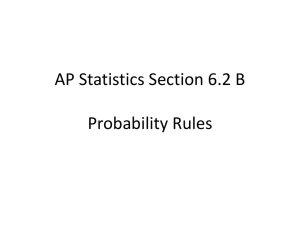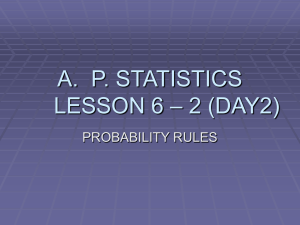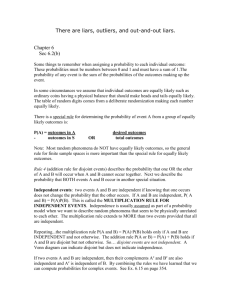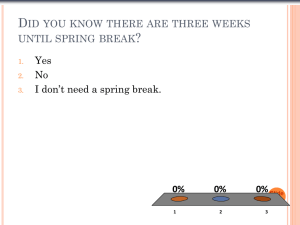(Chapter 6): Probability
advertisement
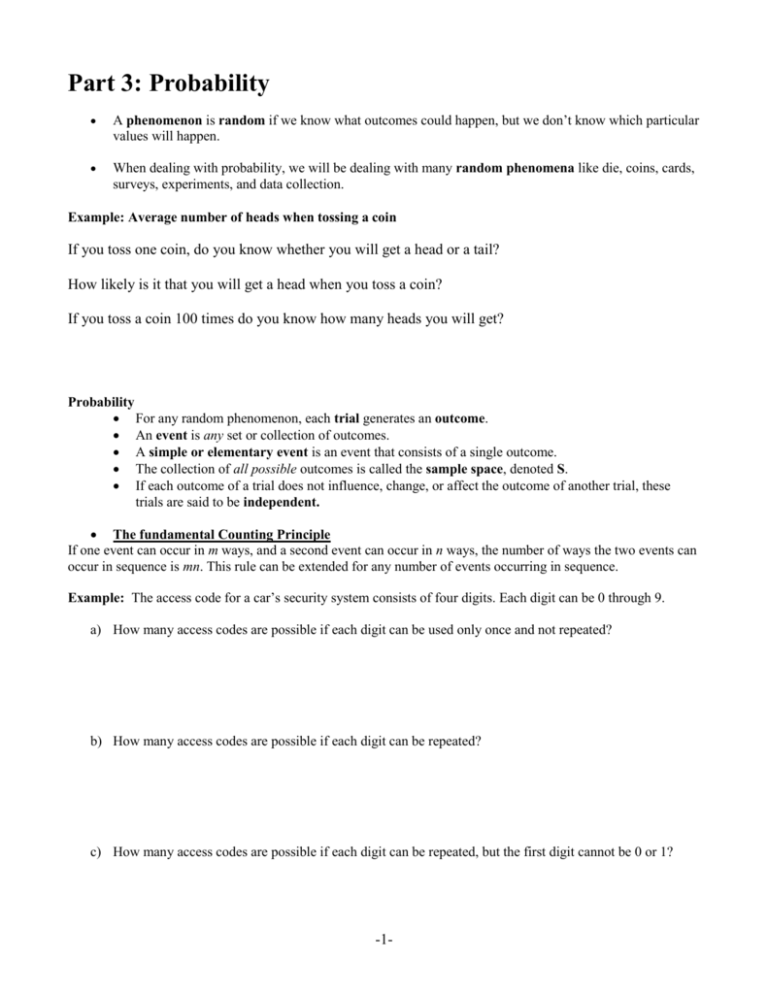
Part 3: Probability A phenomenon is random if we know what outcomes could happen, but we don’t know which particular values will happen. When dealing with probability, we will be dealing with many random phenomena like die, coins, cards, surveys, experiments, and data collection. Example: Average number of heads when tossing a coin If you toss one coin, do you know whether you will get a head or a tail? How likely is it that you will get a head when you toss a coin? If you toss a coin 100 times do you know how many heads you will get? Probability For any random phenomenon, each trial generates an outcome. An event is any set or collection of outcomes. A simple or elementary event is an event that consists of a single outcome. The collection of all possible outcomes is called the sample space, denoted S. If each outcome of a trial does not influence, change, or affect the outcome of another trial, these trials are said to be independent. The fundamental Counting Principle If one event can occur in m ways, and a second event can occur in n ways, the number of ways the two events can occur in sequence is mn. This rule can be extended for any number of events occurring in sequence. Example: The access code for a car’s security system consists of four digits. Each digit can be 0 through 9. a) How many access codes are possible if each digit can be used only once and not repeated? b) How many access codes are possible if each digit can be repeated? c) How many access codes are possible if each digit can be repeated, but the first digit cannot be 0 or 1? -1- Empirical (or statistical) frequency (some people say empirical Probability) The probability of an event is the proportion of times the outcome of a random phenomenon would occur in a very long series of repetitions (long-run frequency). Frequency = Number of times A occurs Number of trials Classic Approach to Probability(theoretical probability) Probability of an Event A: The ratio of the number of favorable outcomes to A to the total number of outcomes in the sample space. P(A)= Number of favorable outcomes to A Number of outcomes in the sample space **Note: This classic approach is useful only when the outcomes of an experiment are equally likely (ex. tossing coins, rolling dice) Law of Large Numbers (LLN): The long-run relative frequency (proportion) of repeated independent events gets closer and closer to the true relative frequency as the number of trials increase. Hence, the larger the number of repetitions, the closer the sample proportion will be to the true population proportion. Or the closer the sample mean will be to the true population mean. Average number of heads when tossing a coin multiple trials Venn diagrams -2- Joint events Disjoint events A or B A or B A and B Formal Probability Rules: Probability Rules: Let A and B be Events and S be the Sample Space 1. 0 ≤ P( A ) ≤ 1 For all events A (A probability is a number between 0 and 1) 2. If S represents the set of all possible outcomes for an experiment, then P (S)=1. S 3. The set of outcomes that are not in the event A is called the complement of A ( A c ). P(A) + P( Ac )= 1, therefore, P ( Ac )= 1 – P (A) and P(A)= 1- P( Ac ) Ac A 4. “Addition Rule” [“OR”] -3- Complement Rule A or B is known as the union of the two events: it is the probability of A or B or both. A) General “Addition Rule” for Two Events For events A and B the general addition rule is: P (A or B) = P (A) + P (B) - P (A and B) B) Disjoint Events If events A and B are Disjoint (or mutually exclusive) meaning they have NO outcomes in common and cannot occur together, the probability that one or the other occurs is the sum of the probabilities. P (A or B) = P (A) + P (B) A B **Note that it is the same addition rule as before except for disjoint events the Probability of A and B, is equal to zero, so it reduces to P (A or B) = P (A) + P (B). Example: You draw one card from a standard deck of cards: Find the following probabilities: a. P(A)= Probability of drawing a spade b. P(B)= Probability of drawing a King c. P(C)= Probability of drawing an Ace d. P (B and C) B and C are ________________ events e. P (B or C) f. P(A and B) A and B are ________________ events g. P(A or B) 5. “Multiplication Rule” [“AND”] -4- A and B is the intersection of the two events: it is the probability both A and B will occur. A B A B A) General “Multiplication Rule” for Two Events [“AND”] If events A and B are dependent (the occurrence of one event changes the likelihood that another event will occur), this is called a “Conditional Probability.” We write P(B|A) and read this as: “The probability of B given A.” For events A and B the multiplication rule is: P (A and B) = P (A) P (B | A) This multiplication rule can be rearranged to solve for the conditional probability: P (B| A) = Note: P (B | A) = PA B PA P A B P A is not the same as: P (A | B) = PA B PB A) Two Independent Events If events A and B are INDEPENDENT (the outcome of one trial does not affect the outcome of the next event): P (A | B) = P (A) P (B | A) = P (B) For two independent events A and B, the probability both A and B will occur is the product of the probabilities of the two events. P (A and B) = P (A) P (B) Watch out for the following: 1) Make sure that your probability distribution is legitimate. Recall that if you list all possible probabilities in your sample space, then they should total to 1. -5- 2) Don’t add probabilities of events if they are not disjoint. This first addition rule only applies if the two events cannot occur at the same time. 3) Don’t multiply probabilities of events if they are not independent. This is a typical mistake in statistics. You must show that the probability of one event has no affect on the probability of another event occurring. Don’t just assume they are independent. 4) Disjoint and Independence have completely different definitions: Example: Suppose you have the following events: A= you get an A in this class and B= you get a D in this class Are these two events disjoint? Are these two events independent? Example #1: Red Lights A commuter must pass through five traffic lights on her way to work each day, and will have to stop at each one that is red. She estimates the probability model for the number of red lights she hits, as shown below. Number of red lights (X) Probability P (X) 0 0.05 1 0.25 2 0.35 3 4 0.15 5 0.05 Suppose one trip to work is selected at random. a. What is the probability that she hits at least 3 red lights on that trip? b. What is the probability that she hits no red lights and 5 red lights on that trip? c. Are these events disjoint? Why? Example #2: According to the National Center for Health Statistics (www.cdc.gov/nchs/) seventeen percent of adolescents’ ages 12-19 years are overweight. a) If five adolescents are selected at random (so we can assume independence), find the probability all will be overweight. -6- b) If five adolescents are selected at random, find the probability that none will be overweight. c) If five adolescents are selected at random, find the probability that at least one will be overweight. Example #3: Suppose P(A) = 0.20 and P(B) = 0.10, if A and B are independent: a) What is P(A and B)? b) What is P(A or B)? Example #4: 39% of new model cars have a built in DVD player, 21% have a GPS navigation system, and 47% have at least one of these two features. What is the probability that a new model car has both of these features? A. 0.60 B. 0.0819 C. 0.08 D. 0.13 E. 0.26 Example #5: A slot machine has three wheels that spin independently. Each has 10 equally likely symbols: 4 bars, 3 lemons, 2 cherries, and a bell. If you play, what is the probability: a. You get 3 lemons? b. You get no bars? c. You get at least one bar? Example #6: Is hair loss pattern related to body mass index? A study of 769 men showed the following numbers: Hair loss pattern Body Mass Index None Frontal Vertex Total Under 25 137 22 40 199 -7- 25-28 Over 28 Total 218 153 508 34 30 86 67 68 175 319 251 769 a. What is the probability that a randomly selected man has body mass index over 28 and has frontal hair loss pattern? b. What is the probability that a randomly selected man has body mass index under 25 or has frontal hair loss pattern? c. If a randomly selected man has a body mass index between 25 and 28, what is the probability he has a Vertex hair loss pattern? d. Is hair loss pattern independent of body mass index? Explain using probabilities calculated from the above table. Using Venn Diagrams to solve problems -8- Example #1: After conducting a survey of a large number of adults, 81% of whom were over 30, the National Sleep Foundation reported that 32% of the respondents were over 30 and snored. 15% of the respondents were not snorers and were under 30.Let A be the event that an adult is over 30. Let B be the event that an adult snores. a. Fill in all 4 areas of the Venn diagram below with the appropriate probabilities. A B b. What percentage of the respondents were over 30 and did not snore? Example #2: A study found that 48% of college students have laptop computers and 53% have desktop computers. It was also found that 79% of college students have either a laptop or desktop. Let L be the event a student has a laptop and D be the event a student has a desktop computer. a. What is the probability that a student selected at random has both a laptop and desktop computer? b. Fill in all 4 areas of the Venn diagram below with the appropriate probabilities. L D c. Given that a student has a desktop computer, what is the probability that the student has a laptop? d. Is owning a desktop computer independent of owning a laptop computer? Explain using probabilities calculated from the information above. Sampling with replacement: an object or individual selected gets put back into the population before the next selection is made. -9- Sampling without replacement: an object or individual selected gets removed and not returned to the population before the next selection is made. Example #1: Consider a preschool class with four left-handed children and six right-handed children. Two children are selected without replacement. Let X be the number of left-handed children chosen. a) Find the probability no left-handed children are chosen. b) Find the probability two left-handed children are chosen. c) Find the probability exactly one left-handed child is chosen. Example #2: Suppose a fun-size bag of skittles has 5 red, 7 green, 6 purple and 8 yellow (a total of 26 skittles). You select two skittles from the bag, one at a time, without looking. (Without Replacement) a. What is the probability that both of the skittles are green? b. The probability that exactly one of the two skittles is red is: A) 0.037 B) 0.162 C) 0.323 D) 0.311 E) 0.155 Example #3: An ice chest contains four cans of Coke, three cans of Pepsi, and two cans of Sprite. Two cans are selected at random, one after the other without replacement. What is the probability that exactly one of the two cans is a Pepsi? Answer: Tree Diagrams: When conditional probabilities are given, a tree diagram can be useful to compute probabilities. -10- Example #1: Given that students attend a final review session, they have a 90% chance of passing the final exam, and given they don’t attend the final review session, they have a 15% chance of passing the final exam. The Professor estimates that 65% of the students will attend the final review session. Let event A be that a student attends the review session, event P be that a student passes the final. Fill in the blank areas of the probability tree below. P (P | A) P (A and P) ________ ______ P (A) P (Pc | A) _____ P (A and Pc)_________ ______ P (P | Ac) P (Ac) P (Ac and P) ________ ______ _____ P (Pc | Ac) P (Ac and Pc)________ _______ What percentage of students passed the final exam? a) 13.5% b) 63.8% c) 15% d) 58.5% e) 36% Bayes’ Rule (page 158 in text): When we have P(B|A) but want the reverse probability P(A|B), a tree diagram can be a useful way to compute these reverse conditional probabilities. Bayes’ Rule (below) is a formula for calculating the reverse probability from the original conditional probabilities given: we will use the tree diagram method as it is easier. P( A | B) P( A B) P( A) P( B | A) P( B) P( A) P( B | A) P( A c ) P( B | A c ) Example #2: In a certain geographic location, the probability a person has a college degree (A) is 0.25. If a person has a college degree, the probability he earns more than $100,000 per year (B) is 0.10. If a person does not have a college degree, the probability he earns more than $100,000 is 0.04. -11- a) Draw a tree diagram that organizes this information: clearly label each branch of the diagram with the appropriate probability. b) What is the probability a person in this geographic location earns more than $100,000? c) Given that a person in this geographic region earns more than $100,000; what is the probability the person has a degree? d) The events “has a college degree” and “earns more than $100,000” are: a) disjoint and independent b) joint and independent c) disjoint and dependent d) joint and dependent e) joint only Permutations A permutation is an ordered arrangement of objects: -12- The number of different arrangements of n objects is n! The number of permutations of n objects taken r at a time is n Pr n! (n r )! Example #1: The starting lineup for a baseball team consists of 9 players. How many different batting orders are possible using the starting lineup? Example #2: The offices of president, vice president and treasurer for an environmental club will be filled from a pool of 14 candidates, six of whom are members of the debate team. What is the probability that all of the offices are filled by members of the debate team? Combinations A combination is a selection of r objects out of n objects when order does not matter. The number of combinations of n objects taken r at a time is n Cr n! (n r )! r! Example: Find the probability of being dealt five diamonds from a standard deck of playing cards? Practice Problems Use the following information for problems 1-4 Suppose the probability that a college student has a MySpace site (event A) is 0.61 and the probability that he/she has a Facebook site (event B) is 0.49. It is known that 26% of the students have neither site. -13- 1. What is the probability a student has both a MySpace site and a Facebook site? 2. Fill in the probabilities in the Venn diagram below: clearly label each of the four areas of the diagram with the appropriate probability. A H 3. Given that a student has a MySpace site, what is the probability the student has a Facebook site? 4. Is having a Facebook site independent of having a MySpace site? Justify your answer using probabilities calculated above. Use the following to answer questions 5-8: Leah is flying from Boston to Denver with a connection in Chicago. The probability her first flight leaves on time is 0.15. If the flight is on time, the probability that her luggage will make the connecting flight in Chicago is 0.95, -14- but if the first flight is delayed, the probability that the luggage will make it is only 0.65. Let A be the event that the first flight leaves on time, let B be the event that the luggage will make the connecting flight. 5. Are events A and B independent? Explain your answer. 6. Draw a tree diagram below: use correct notation to label events and fill in all appropriate probabilities (including intersections) 7. What is the probability that her luggage arrives in Denver with her? 8. If her luggage does not arrive in Denver with her, what is the probability her first flight did not leave on time? -15- SUMMARY: Make sure that you understand this. A. Frequencies and Probabilities A trial and an outcome. An elementary event and an event. A simple or is an event that consists of a single outcome. Sample space S. Independent trials. The fundamental Counting Principle Frequency = Number of times A occurs Number of trials Classic Probability: P(A)= Number of favorable outcomes to A Number of outcomes in the sample space Law of Large Numbers (LLN). B. Operations with events and Venn diagrams Joint and disjoint events. 2. Union: A and B. 3. Intersection: A or B. 4. Complement Ac 1. 5. General “Addition Rule” for Two Events: P (A or B) = P (A) + P (B) - P (A and B) For Disjoint Events: P (A or B) = P (A) + P (B) C. Conditional probability and “Multiplication Rule” -16- P (B| A) = P A B P A P (A and B) = P (A) P (B | A) For Independent Events: P (A | B) = P (A), P (B | A) = P (B). D. A Tree Diagram. E. Bayes’ Rule F. Permutations and Combinations. -17-
